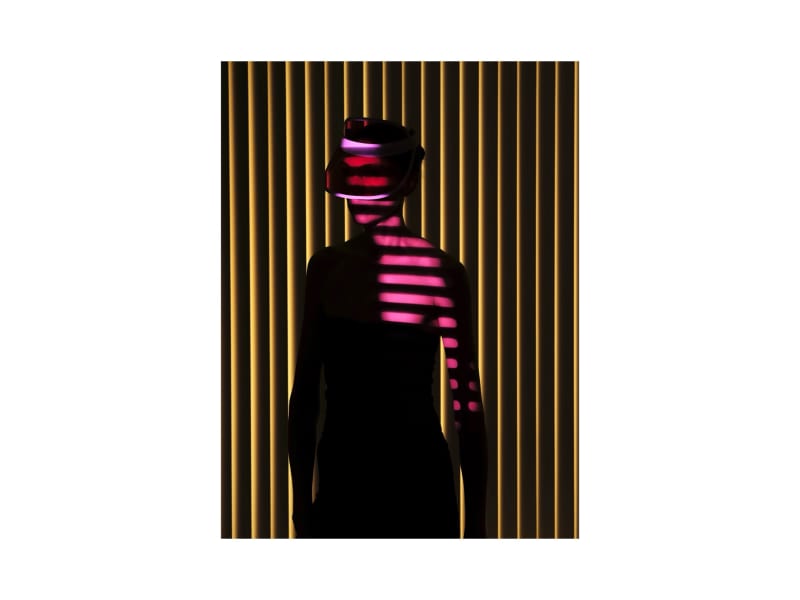Hannah Whitaker’s exhibition Shadow Detail includes several interrelated components: new photographs, a large collaged triptych, a video work, and several sculptural lamps. An expansion of the photographic series featured in her recent book Ursula, Whitaker’s latest work similarly investigates the rich and estranging sensory potential of silhouettes and patterns. Working with the same model she collaborated with in Ursula, Whitaker continues to push the human form into alien terrain, at times wrapping the body with highly reflective tape that lends it a robotic quality, or draping it with aluminum tubing that appears like an ersatz life support system. Increasing the size of the work while depicting more of the model’s body, Whitaker forces us to encounter the figure, sometimes veiled in patterned shadow and always completely isolated, on a scale of equal footing. Yet increasing the size of the works to human scale has the paradoxical effect of widening the distance between the figure in her lonely, futuristic world, and our own quotidian, much less Technicolor reality.
The photographs that emerge from Whitaker’s exploration sometimes silhouette the model’s lithe form against bright, monochromatic backgrounds, which further emphasizes the metallic asperity of the props Whitaker employs. More so than in her Ursula works, here Whitaker obscures the model’s facial features, casting her in a darkness that allows the human body to screen the disorienting effects of the projected light and the highly reflective props.
The artificiality of the world Whitaker creates extends to the two still lives included in the exhibition, which she composed by building towers out of the same props deployed in the portraits. The objects in these still lives, with their extreme vertical orientation, stand at attention like sentinels, as though they too are tall, lissome figures arrested in positions of provisional rest. Like the sculptural lamps interspersed in the gallery, the objects depicted in the still lives are composed of disparate fragments that cohere, however precariously, into single, poised compositions.
The dynamic between stasis and control, gesture and movement, is likewise explored in Whitaker’s first foray into video. Filming the same model in a sequence of brief episodes, Whitaker emphasizes the gap between posing, and the time between intentional gestures. Moments familiar from the photographs are taken out of their frozen temporality, allowing Whitaker to use video to elongate the instance of a photograph into a play with props in real time. In contrast, in Tangled, a three-panel collage, the positions, though not the patterns, of all the elements have been determined beforehand. Laying down a layer of black and white vertical stripes using acrylic paint, Whitaker brings the paint to the edges of a large central form interrupted by hot pink slashes, a color that conjures the bright pink cover of the Ursula volume. At the left edge of the work three silhouettes of Whitaker’s model are visible, the topmost shown with a snakelike protruding tongue. In the right upper corner of Tangled, a silhouette of the model’s long arm ends with an accusatory pointed finger, as though scolding the tongued head at the left. A large inner, cloud-like form is created from various textures and patterns—polka dots, grey scale skyscapes, and iridescent cellophane—and hangs like a jumbled thought bubble in the center of the image. The repeated silhouettes of the model’s profile guard the perimeter of the work like a small detachment of troops-- a shadow detail-- assigned to patrol the chaotic forms of the central tangle, but only by inserting their own absurd and slightly menacing tongue wagging and finger pointing gestures.
- Eva Díaz
Born in 1980, Hannah Whitaker is an artist based in Brooklyn, NY.
She holds a BA from Yale University and an MFA from the ICP/Bard College.
Selected exhibitions include those at M+B, Los Angeles; Marinaro, New York; Galerie Xippas, Paris; Cincinnati Art Museum, Ohio; Galerie Nara Roesler, Sao Paolo; Casey Kaplan, New York, and Cherry and Martin, Los Angeles. She was included in Rencontres d’Arles in France, where she was nominated for the Discovery Prize; in addition to Foam Talent, which travel to Amsterdam, Paris, and Dubai; the Public Art Fund’s citywide exhibition Commerical Break; and New Visions: The Henie Onstad Triennial for Photography and New Media at the Henie Onstad museum in Norway.
She has published monographs with Mörel Booaks (London) and Image Text Ithaca Press (Ithaca, NY). Selected press includes The New Yorker, Frieze, Modern Painters, Los Angeles Times, Hotshoe, Libération, and Art Review, artpress, IMA, among others.
~~~
Eva Díaz is an art historian and critic living in Rockaway Beach, New York. She is an associate professor in the History of Art and Design department at Pratt Institute in Brooklyn.
Her book The Experimenters: Chance and Design at Black Mountain College was released by the University of Chicago Press in 2015.
She writes for magazines and journals such as Aperture, The Art Bulletin, Artforum, Art Journal, Art in America, Cabinet, Frieze, Grey Room, Texte zur Kunst, Harvard Design Magazine, and October.
She has recently completed the manuscript to her new book After Spaceship Earth, analyzing the influence of R. Buckminster Fuller in contemporary art, a project supported by the Graham Foundation and a Warhol Foundation / Creative Capital Art Writers Grant.
Recent sections, published in New Left Review, Aperture, e-flux journal, and Texte zur Kunst, take up artists’ challenges to a privatized and highly-surveilled future in outer space, and how the space “race” and colonization can be reformulated as powerful means to readdress economic, gender, and racial inequality, as well as ecological injustices.

